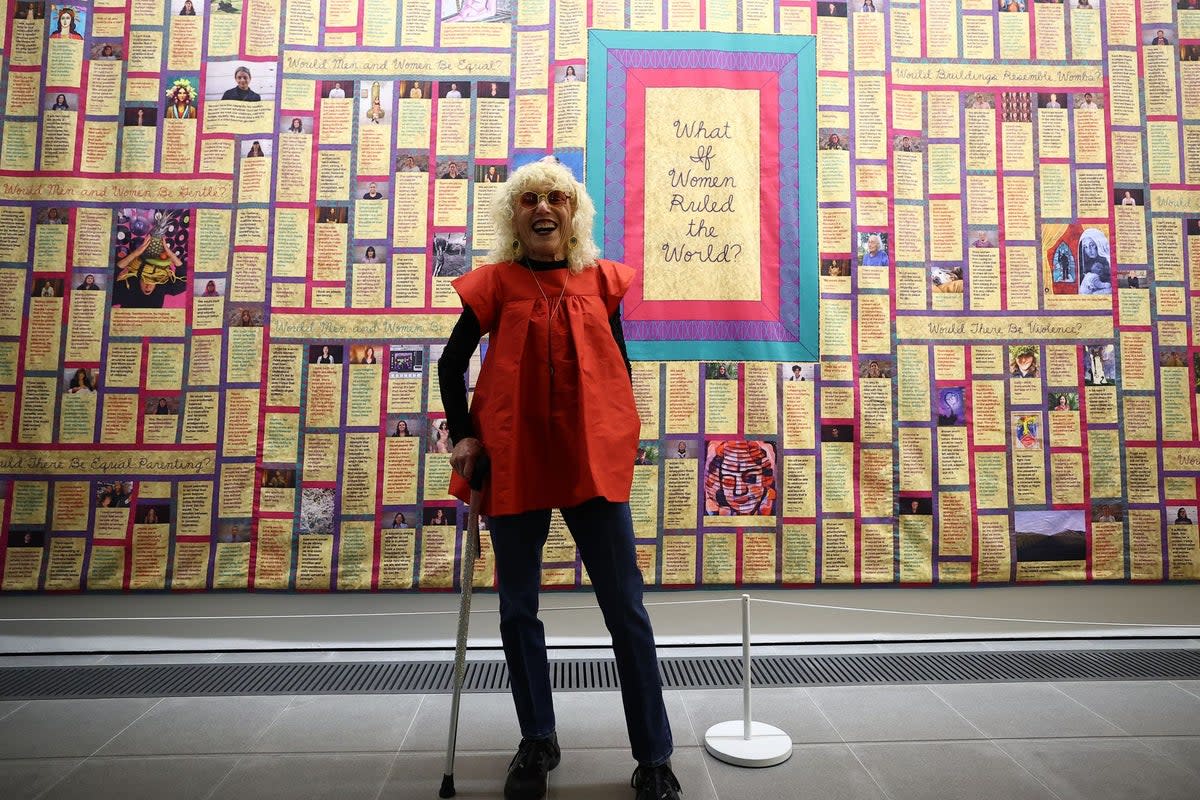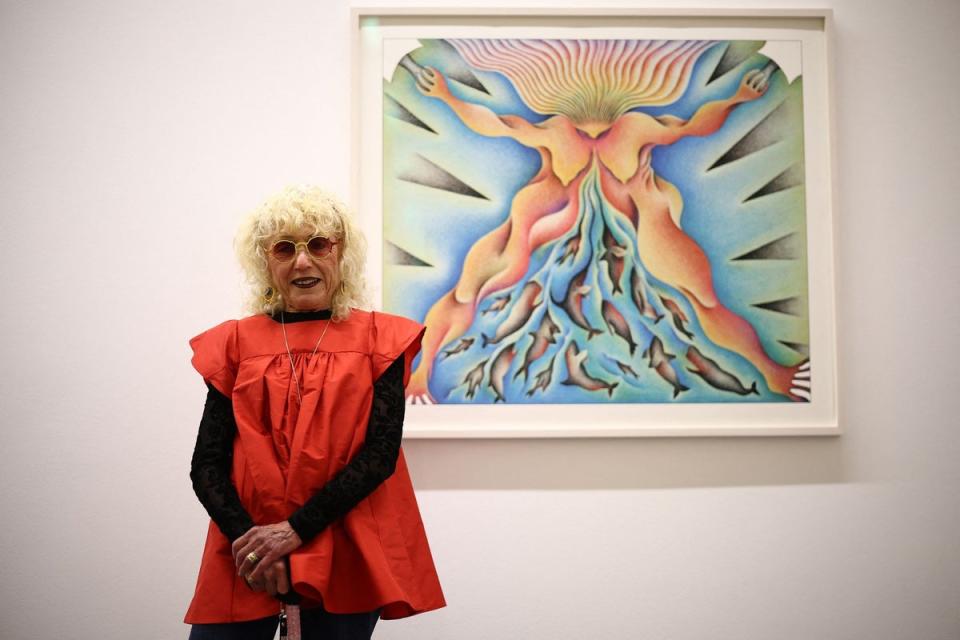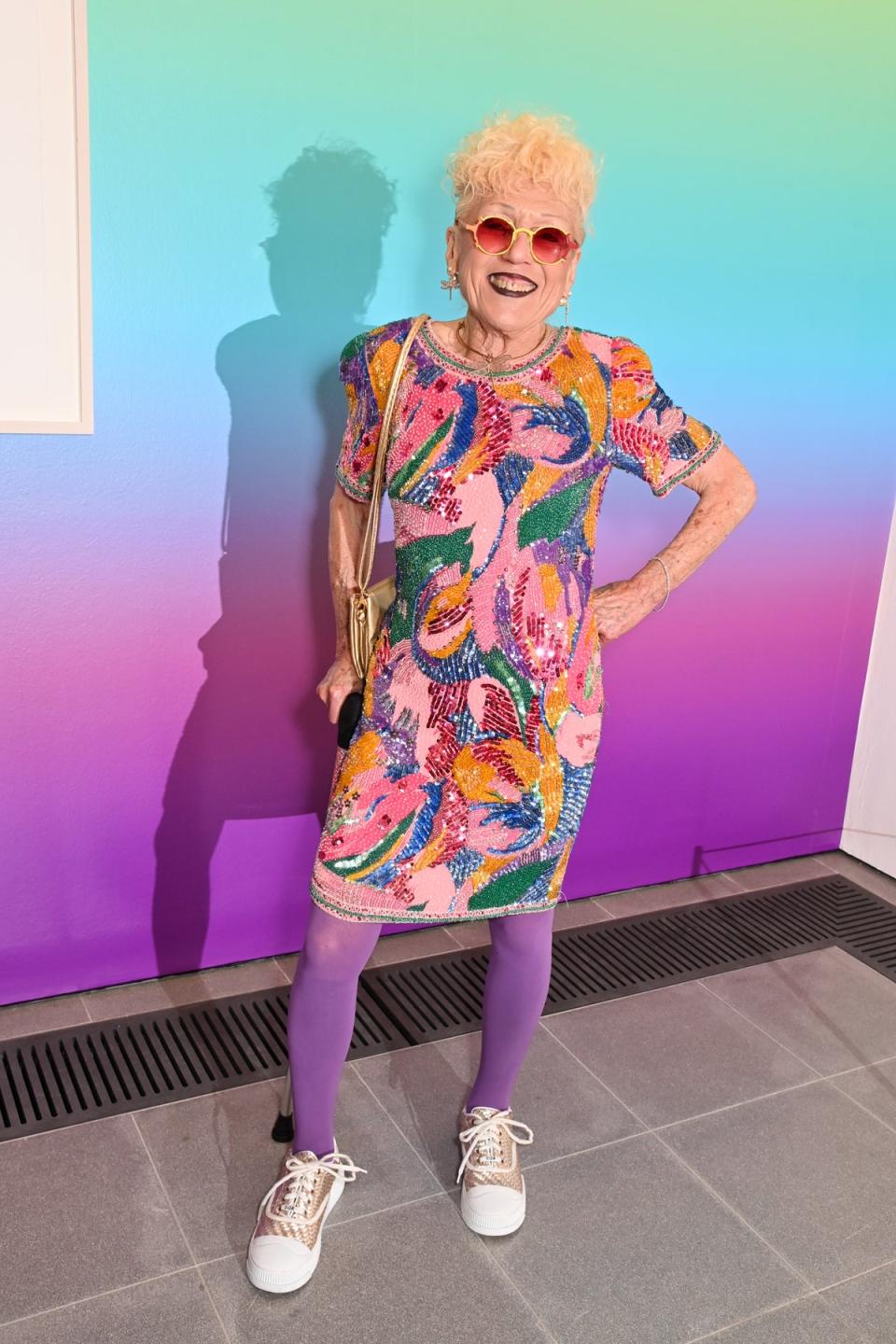Feminist firebrand Judy Chicago on her new London art retrospective: 'It's so overwhelming'

On the eve of her retrospective at London’s Serpentine North Gallery, artist Judy Chicago is visibly moved. “It’s so overwhelming for me, because there’s a lot of work in this show I never thought would be shown.”
Even at the age of 84, Chicago looks like a rock star with bleached blonde hair and gold nails. Dressed in a red smock and boot-cut jeans, she carries a glittery cane. She knows how to make her presence felt.
She always has. A pioneer of the feminist art movement, Chicago came to prominence in the Sixties, challenging the male-dominated art world. Over a seven-decade career, she has known loneliness and adversity. At times she had to sell her work because she couldn’t afford to store it. She received threats over her more polemical pieces, exploring birth and creation, toxic masculinity and the absence of the Holocaust in modern art (Chicago is Jewish).
But now Chicago is having a moment. She has been named one of Time magazine’s 100 Most Influential People, and long-forgotten pieces are being celebrated. She is also the focus of major retrospectives, such as this one at the Serpentine, which is her largest solo show in a London gallery.
As she prepares to open this exhibition in west London, the capital is awash with shows by pioneering female artists. Yoko Ono has a retrospective down the road at Tate Modern. Tate Britain currently has a major show about female artists in Britain from 1520 to 1920, which follows hot on the heels of Women in Revolt! Art and Activism in the UK at the same gallery.

Are women finally getting their due? “Well, because I know so much about history, this is not the first time in history where women artists have become prominent,” Chicago says. “It’s always push forward, push backwards. And we’re watching, simultaneously, a push forward and a push backwards, right now.”
We talk about the threat to women’s reproductive rights in America; hopefully a whole new generation of young women are being radicalised by the threats to their freedoms. “I don’t know,” she sighs. “You don’t see American women marching on the Supreme Court around Roe v Wade. They’re all occupied with other subjects they somehow think are more important than the right to their own bodies.”
She’d like young people to get off their phones. “It’s not just going to a protest. All the social change movements of the Seventies were built on long, hard work. You know, consciousness-raising groups, the creation of women’s organisations, civil rights groups, the organisation of farmworkers, Stonewall, all of those movements, had deep organisational roots. They weren’t just like, ‘Oh, stand out, wave a flag and take a picture and post it,” she adds dryly.
For Chicago, the activism still burns within her. Not just with the promotion of women but also the environment. In the show there’s the 1980 Rainbow Warrior poster she designed for Greenpeace (which looks as radical as ever today). And more recently she teamed up with Jane Fonda (“she’s a real pistol”) and her environmental initiative Fire Drill Friday to launch #CreateArtforEarth, to encourage art that addresses the climate crisis.
“I mean, who isn’t angry about the suffering in the world? I became so conscious about it when I did my Extinction series,” Chicago says.
“Although it was difficult to deal with the mortality section — we’re all going to die and OK, I wanted to grapple with that — but when I began to compress what we’re doing to other creatures and the scale at which we’re doing it, I spent two years in unremitting grief. You know, we studied the cruelty of human beings during the Holocaust, but the cruelty to the creatures on the planet…”

Judith Sylvia Cohen was born in Chicago in 1939 (she changed her name in 1970, as a gesture of protest against “male social dominance”). Her father was a labour organiser and Marxist; her mother a dancer turned medical secretary.
By the age of five, Chicago knew that she “never wanted to do anything but make art” and took her Bachelor of Arts at the University of California in 1962. Her early works were abstract, minimalist. Gradually the shapes began to wiggle, glow, split open, symbolising the orgasmic female body. Today she calls it the moment “where I decided not to try to be a guy”.
Her London show Revelations concentrates on drawing throughout her career and brings together new and little-seen sketchbooks, films and slides and studies relating to her most famous works.
The title came about when Chicago showed Serpentine director Hans Ulrich Obrist an unpublished manuscript she had given that name — kept in her drawer for 50 years. He immediately saw this “feminist bible” should be the exhibition catalogue.
Also on display for the first time are her Seventies coloured smoke works in their entirety, while visitors can go on a virtual tour of possibly Chicago’s most famous work, The Dinner Party, seen as the first epic feminist artwork. On a huge table, place settings reflect the accomplishments of 39 guests (Sappho, Emily Dickinson, Virginia Woolf).
But the plates are painted with highly stylised images of female labia. Although some male art critics dismissed it as “vaginas on plates”, The Dinner Party is now housed in the Brooklyn Museum.
Her 30ft canvas In the Beginning, which runs the width of the Serpentine, is also on display. It is part of her Birth Project series from the Eighties, created because she was shocked by the lack of imagery of birth in art.

Despite three marriages, Chicago was never interested in motherhood. “I used to joke that you didn’t have to be crucified to paint the crucifixion. I mean, that’s just a complete misunderstanding of art. And also, you know, I studied birth, witnessed births, looked at the history of birth in different countries.
“My own mother went to the hospital, was anaesthetised, woke up, and she had one kid and then another kid, So how would that qualify her to create about an experience that she was basically not there for?”
She is touchingly devoted to photographer Donald Woodman, her husband of 38 years — they live in a historic railroad hotel in Belen, New Mexico, and have worked on many projects together — and he is there in the background as we talk.
She compares her career to her idol, Leonard Cohen, who toured in his eighties after his accountant embezzled his money. “He said, ‘Thank you for keeping my music alive.’ So I have the same gratitude for keeping my art alive.”
Judy Chicago: Revelations is at Serpentine North from May 23 to September 1, serpentinegalleries.org


